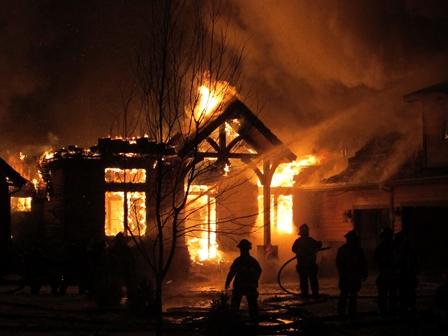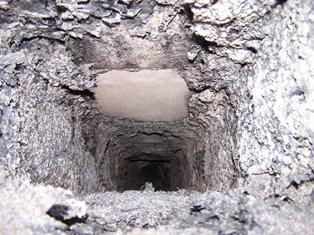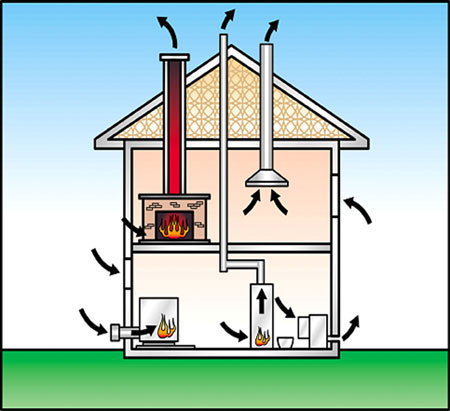Even
though you can't see it, the air in your house is constantly in motion.
In general, airflow tries to flow out of your house in the upper parts
and make up air tries to flow into your house in the lower parts of your
house. Thinking of your house as a system makes it easy to
understand the reasons for that airflow. The actual flow of air into and
out of any home is influenced by a number of constantly changing
factors, including: stack effect; wind loading; interior mechanical
systems and fuel-burning appliances such as furnaces, fireplaces, wood
stoves and water heaters.
Homes
built in the past 25 years, and older homes that have been renovated,
have been made more airtight. This makes it much more difficult for
makeup air to enter the home. As the saying goes, “hot air rises”, and
so does the warm air in your home.
When the warm air rises to the upper areas it's called the stack effect.
That trapped air creates a pressurized area and forces its way out -
through even very small openings such as recessed light fixtures and
window frames. At the same time replacement air is trying to enter in
the lower part of the building to make up for the escaping air.
Somewhere
in your house, amid all this airflow, is something called the Neutral
Pressure Plane (NPP). Above this theoretical plane, the air pressure is
slightly positive compared to the outdoor air pressure and is trying to
force its way out of the house. Below the plane, it is slightly negative
and the house is trying to draw air in. The location of the NPP can
constantly change in response to changing conditions.
All of the factors that affect airflow in the house also influence the level of the Neutral Pressure Plane.
Anytime
a fireplace or fuel-fired heating appliance (except direct vent) is
below the plane, air will tend to flow into the house through the
chimney or vent. A common example of this is found in homes with two
fireplaces, one below the other. As the upper level fireplace uses air
for combustion and chimney flow, it depressurizes that level slightly
causing air to flow upwards from the lower level. Since the lower level
fireplace is below the NPP, it draws air into the basement through the
chimney. Unfortunately, since those two flues generally exit the chimney
close to each other, the makeup air can contain some smoke from the
fireplace above and it can pick up unpleasant chimney odors as it passes
down the chimney flue.
Wind-loading is
the effect on interior house pressures caused by the wind. When wind
strikes a building, it creates high pressure on the side that it hits
and low pressure on the downwind side. Any open windows or doors on the
windward side will help to pressurize the house, increasing chimney
draft. However, openings on the downwind (leeward) side will
depressurize the house and increase the likeliness of backdrafting from
chimneys or vents. Backdrafting is a reversal of the airflow in which
the smoke is coming into the house instead of going up the chimney.
Interior mechanical devices such
as clothes dryers, kitchen fans, bathroom fans, attic fans and central
vacuums can also create depressurization by removing large volumes of
air from the house. The result is often negative pressure in the area of
a fireplace, woodstove, or other fuel-fired heating appliance making it
increasingly difficult for natural draft chimneys to function as
intended.
Another
mechanical system that commonly removes air from the house is a
forced-air furnace. Many such systems are out-of-balance due to leaks in
the ducts. Leaky supply ducts cause air to be blown into the attic or
crawlspace. Leaky return ducts draw air from the basement or other areas
they pass through.
Furnaces,
water-heaters, fireplaces and woodstoves are examples of fuel-burning
appliances that require large volumes of air for combustion. Unless they
are specifically equipped to draw air in from outside the house, such
as direct vent appliances, operating them can reduce the inside air
pressure. There are a variety of mechanical devices on the market that
help provide the necessary make up air to balance the air pressure needs
of your house system.
Draft and Flow Many
experienced chimney professionals use the similarities between water
and air to explain the way your chimney works. Although most people
don't realize it, the air moving up your chimney works under the same
set of physical principles as water flowing in a hose or pipe.
When
a fireplace chimney is full of hot air, it actually pulls air through
the firebox. This pulling effect is called draft and it corresponds to
the amount of pressure in a water hose - the only difference is that the
air pressure is negative and the water pressure is positive (think of
using a straw to drink with instead of to blow bubbles). Thus, a chimney
is called a negative pressure system. Increasing the
draft in your chimney is like opening the faucet wider on the hose. The
simplest way to increase the draft in your chimney is to burn the fire
hotter - hotter air is lighter, so it has more pull.
Another way to get more draft is to increase the height of your chimney -
except when the chimney is already so tall that frictional forces
negate the effect of the extra height.
Given
the same amount of pressure, a larger pipe can obviously carry a
greater volume of water than a smaller one. The same is true for
chimneys - with the same amount of draft (pressure) a larger flue will
exhaust more smoke from your fireplace than a smaller one. But just as a
water hose can be kinked or plugged, the airflow in your chimney can
have a restriction that slows down the smoke flowing up the chimney.
Some of the reasons for poor flow in a chimney are: excessive creosote
deposits; closed or plugged dampers; improper construction; structural
damage or even a dirty chimney cap. In fact, having a plugged-up chimney
cap at the end of your chimney is just like having a
closed nozzle at the end of a hose - you just can't get any airflow
through the chimney. Your CSIA Certified Chimney Sweep can evaluate your
chimney and recommend any corrective action to ensure that it is
capable of the proper draft and flow.

 chimney–and
the flue that lines it–adds architectural interest to your home, but
its’ real function is to carry dangerous flue gases from your fireplace,
wood stove or furnace safely out of your home. A chimney helps your
household air stay
chimney–and
the flue that lines it–adds architectural interest to your home, but
its’ real function is to carry dangerous flue gases from your fireplace,
wood stove or furnace safely out of your home. A chimney helps your
household air stay 
 If
you think a chimney fire has occurred, call a CSIA Certified Chimney
Sweep® for a professional evaluation. If your suspicions are confirmed, a
certified sweep will be able to make recommendations about how to bring
the system back into compliance with safety standards. Depending on the
situation, you might need a few flue tiles replaced, a new liner system
installed or an entire chimney rebuilt. Each situation is unique and
will dictate its own solution.
If
you think a chimney fire has occurred, call a CSIA Certified Chimney
Sweep® for a professional evaluation. If your suspicions are confirmed, a
certified sweep will be able to make recommendations about how to bring
the system back into compliance with safety standards. Depending on the
situation, you might need a few flue tiles replaced, a new liner system
installed or an entire chimney rebuilt. Each situation is unique and
will dictate its own solution.  At
first, this might sound complicated. But really it isn't. Here are some
simple scientific fundamentals to explain how and why a chimney works -
or maybe why it doesn't. This brochure is designed to make it easy to
follow along with the procedures a knowledgeable CSIA Certified Chimney
Sweep® will use to diagnose smoking or odor problems with your chimney.
At
first, this might sound complicated. But really it isn't. Here are some
simple scientific fundamentals to explain how and why a chimney works -
or maybe why it doesn't. This brochure is designed to make it easy to
follow along with the procedures a knowledgeable CSIA Certified Chimney
Sweep® will use to diagnose smoking or odor problems with your chimney. 